Craig Evans and I were having a chat about the James Ossuary. He was about to give a lecture at Liberty University about Jesus and the Remains of his Day. We were discussing the fact that the James ossuary, unlike any of the other ones I’ve seen from the period appears very pitted and worn on the surface. It doesn’t have the smooth limestone surface of numerous other ossuaries of the period, including those in the Talpiot tomb and the famous Caiaphas ossuary. It appears to have endured long exposure to the elements in a way not true of the other ossuaries in question.
Now we have a new report in the NY Times and other papers around the world that proports to provide us with more compelling evidence that: 1) the James ossuary came from Talpiot Tomb A, and 2) that therefore Talpiot Tomb A mus be the tomb of Jesus, complete with his ossuary and those of other family members. Before we get too hasty pudding with such dramatic conclusions several things need to be pointed out.
With or without the new evidence Shimon Gibson, who was one of the original excavators of Talpiot Tomb A has this to say on the matter—-“I myself have excavated a handful of tombs that were open and filled with soil,” Dr. Gibson said. “Personally I don’t think the James ossuary has anything to do with Talpiot.”
There is in addition the comment of the owner of the James ossuary, Oded Golan who allowed the new testing on the James ossuary, prefaced by the comment from the original news article: “Even if the chemistry is correct, the James ossuary could have come from another tomb in East Talpiot, Mr. Golan posited, adding that such research required samples from a much broader test base. “It is very interesting but not enough to determine anything conclusively,” Mr. Golan said of Dr. Shimron’s work. “You would need samples from at least 200 to 300 caves.”
Who is Dr. Aryeh Shimron? He is a 79 year old geologist, whose expertise is in plaster. Not ossuaries made of limestone, but plaster. He was a senior researcher for the Geological Survey of Israel, members of which originally authenticated the James ossuary in regard to its inscription. Unfortunately Ammon Rosenfeld is no longer with us, and could not be asked to comment on Dr. Shimron’s theory. The theory runs as follows— there was an earthquake in Jerusalem which caused all sorts of damage and changes in 363 A.D. According to this theory, the earthquake caused massive amounts of soil and mud to entomb the Talpiot Tomb A and dislodge it’s original entrance way. The ossuaries were encased in this soil from then until the time the cave was excavated in 1980. Dr. Shimron admits there may have been some grave robbing during the Byzantine period. His lab work was financed by Simcha Jacobvici, already well known for his initial documentary on the Talpiot Tomb arguing it was the burial tomb of Jesus, a conclusion that the vast majority of scholars of all sorts from all over rejected, or found extremely unlikely. Is this new research some kind of smoking gun, that changes the conversation again? What Shimon was examining was the chemical composition of the Rendzina soil that encased the tomb. His argument is in essence that there is something like a chemical finger print so that if one finds closely similar trace amounts of phosphorus, chrome and nickel — signature components of the type of clayey East Jerusalem soil on both the James ossuary and various of the Talpiot Tomb A’s ossuaries then we may be confident the James ossuary came from that tomb.
Here are reasons to be very doubtful about this whole sort of reasoning: 1) as mentioned above we are not talking about a scientific sampling of enough ossuaries to draw such a conclusion; 2) the earthquake that struck Jerusalem presumably did not just affect the small region of Talpiot. It presumably affected quite a few areas around Jerusalem, and this news just in— the limestone soil in Jerusalem doesn’t seem to vary all that much from place to place. It’s perfectly possible that the same sort of subsidence or fill affect a wide variety of tombs in and around Jerusalem. Shimron at least admits that the James ossuary could at least have come from other tombs in east Jerusalem. I see no reason to limit the discussion to east Jerusalem if we are talking about a significant earthquake, which apparently we are. 3) of course Shimron has not published his results yet, nor has there been peer review of them by other scholars, but nonetheless another Jacobvici movie is already in the works. This is not how proper and objective scholarship is done, either in terms of the financing, nor in terms of the announcements of results. You don’t sort of make a bombshell announcement of conclusions to the press on Easter weekend before other peers have had a chance to weigh in on the evidence, unless of course you are trying to make an impression of a certain sort. And there is little doubt that a certain agenda is being pursued here, as has been clear before with previous films, and in all likelihood with the forthcoming one. Disinterested pure science this is not.
In any case, I am dubious about the whole notion of a ‘chemical fingerprint’, and even if there was a close match of chemical composition, surely the earthquake could have produced the same sort of conditions in a variety of places in and around Jerusalem.













